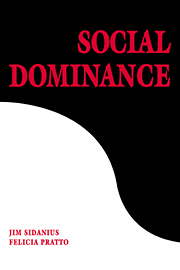Book contents
- Frontmatter
- Contents
- Acknowledgments
- Part I From There to Here: Theoretical Background
- Part II Oppression and Its Psycho-Ideological Elements
- Part III The Circle of Oppression: The Myriad Expressions of Institutional Discrimination
- Part IV Oppression as a Cooperative Game
- Notes
- References
- Author Index
- Subject Index
Part III - The Circle of Oppression: The Myriad Expressions of Institutional Discrimination
Published online by Cambridge University Press: 05 June 2012
- Frontmatter
- Contents
- Acknowledgments
- Part I From There to Here: Theoretical Background
- Part II Oppression and Its Psycho-Ideological Elements
- Part III The Circle of Oppression: The Myriad Expressions of Institutional Discrimination
- Part IV Oppression as a Cooperative Game
- Notes
- References
- Author Index
- Subject Index
Summary
One of the primary means by which societies produce and maintain group-based social hierarchy is through the use of institutional discrimination. By institutional discrimination we are talking about the way that social institutions such as schools, businesses, and government bureaucracies disproportionately allocate positive social value (e.g., high social status, good health care, good housing) to dominants and disproportionately allocate negative social value (low social status, poor housing, long prison sentences, torture, and executions) to subordinates.
There are at least two major distinctions one may make concerning institutional discrimination: individual-mediated and standard-of-practice-mediated institutional discrimination. In addition, one may distinguish between overt and covert institutional discrimination.
Individual-mediated institutional discrimination may be said to occur when individuals with biased, or dominance-oriented, attitudes and beliefs allow these to influence the decisions they make and the actions they take as agents of public or private institutions. For example, a highly prejudiced loan officer might decide not to grant a home mortgage loan to an Asian-American family for no other reason than the fact that he or she dislikes Asians. Standard-of-practice institutional discrimination occurs when an institution's rules and procedures have discriminatory effect, even if it is claimed that there is no discriminatory intent. For example, a fire department might have regulations stipulating that no one may be hired who is not able to carry a sixty-five-pound hose up a two-story ladder within 20 seconds.
- Type
- Chapter
- Information
- Social DominanceAn Intergroup Theory of Social Hierarchy and Oppression, pp. 127 - 130Publisher: Cambridge University PressPrint publication year: 1999



